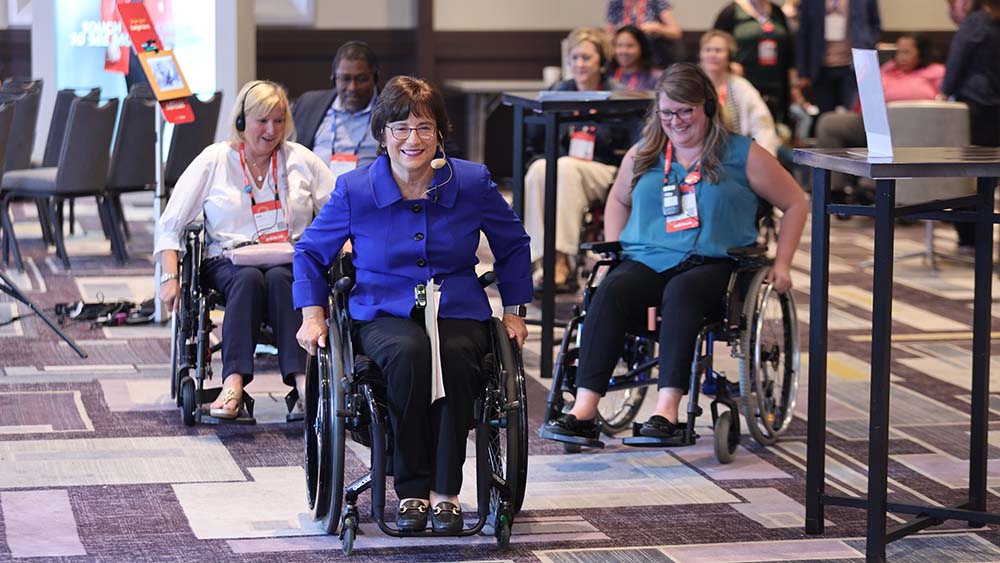
Accessibility advocate Rosemarie Rossetti leads a Tuesday wheelchair tour through the PCMA EduCon venue. (Whatever Media Group)
The saying “you need to walk a mile in their shoes” couldn’t ring truer — and yet be completely off as a metaphor — when it comes to understanding what it’s like to navigate an event as a person in a wheelchair. Yes, you can make sure that your event is ADA — or whatever the host destination country standards are — compliant, but you can’t fully grasp what it would be like for your attendees who use a wheelchair to experience your event until you’ve sat in their seat (there, that’s a more appropriate aphorism).
With that in mind, PCMA offered participants an opportunity to navigate EduCon in a wheelchair, in “Event Mobility & Accessible Design – An Immersive Tour,” on June 26 and 27, led by accessibility advocate Rosemarie Rossetti, Ph.D., who has been in a wheelchair since an accident paralyzed her from the waist down 25 years ago. Rossetti, who is based in Columbus, Ohio, gave an accessibility tour at Convening Leaders 2023 in that city. Rossetti took a small group of us for a test run of the wheelchair tour June 25, which opened our eyes to the challenges those in a wheelchair face when attending events and gave us a better understanding of how to make those events more welcoming to them.
After we got some basic instructions from Rossetti on how to maneuver our wheelchairs and started pushing ourselves around, I was immediately reminded of a recent article Convene had published in News Junkie on how San Diego Comic-Con attendees are disappointed — except for those who are in a wheelchair — that the exhibit hall at the upcoming event won’t be carpeted.
The first thing you realize when pushing yourself in a wheelchair is that it’s far less physically taxing on tile or cement than on carpeting. And there’s a difference in the force you need to exert on different carpeting piles that you wouldn’t necessarily realize on foot. What feels more plush on your feet takes more energy and time to navigate in a wheelchair.
Here’s what else I learned:
Open the Doors
As you maneuver your chair through doorways, it becomes obvious that you need to allow more space than the chair width itself — you’ve also got to have enough room to clear your hands on the wheels and your elbows. Note for planning purposes: Open both doors and use door stops, when possible, for wheelchair accessibility to food functions and sessions.
Lower the Tables
For networking receptions and refreshment breaks, it’s important to have tables low enough for those in a wheelchair to have the same opportunity as everyone else to see what they would like to choose to eat and drink. Note for planning purposes: Have staff or volunteers on hand to help attendees in a wheelchair with both food and drink. While you can balance a plate on your lap in a wheelchair, the only way to also carry a drink while pushing your own wheelchair is between your knees — not a safe option especially when it’s hot coffee or tea, Rossetti pointed out.
Allow More Time
It takes far longer to get from Point A to B in a wheelchair than walking. Especially when backing into an elevator (where my parallel parking skills were useless). Note for planning purposes: Lengthen the time between session starts.
Know How to Ask
Some people don’t know how to ask someone in a wheelchair if they need help. Rossetti said the best way to phrase that question is: “How can I help?” That gives them the option to share how they could use help or to politely decline your offer without making it awkward for either party. Note for planning purposes: Share that phrasing with staff and volunteers.
Signage Is Important
It’s not easy for walking attendees to navigate a new venue at an event — it’s even more difficult for someone using a wheelchair. Rossetti showed us how a lack of signage makes it impossible for someone in a wheelchair to know where the accessibility ramps are. Note for planning purposes: To the untrained eye, ramps that are for catering staff who are wheeling carts are not the same as accessibility ramps (I was guilty of making this mistake). They are too steep in pitch to make it safe for a wheelchair to go up or down.
What can be especially helpful to those in wheelchairs, Rossetti shared, is to feature an accessibility navigation map in the app that may highlight a wheelchair-only access route, which also would help from a flow perspective.
I hope that my temporary experience in a wheelchair won’t fade from memory and that I will look at every event with fresh eyes. Note for planning purposes: It starts with the marketing materials, Rossetti said, where it would be good to include images of attendees in wheelchairs. In the registration form, it’s not enough to have a check-box question asking whether they need wheelchair access. The question should be more open-ended: What accommodations do you need? is much better.
Rossetti accompanies planners on their site visits to make sure they are fully accessible, but she also suggested this gem: Ask ahead of time for a wheelchair to use on your next site visit.
Michelle Russell is editor in chief of Convene.
